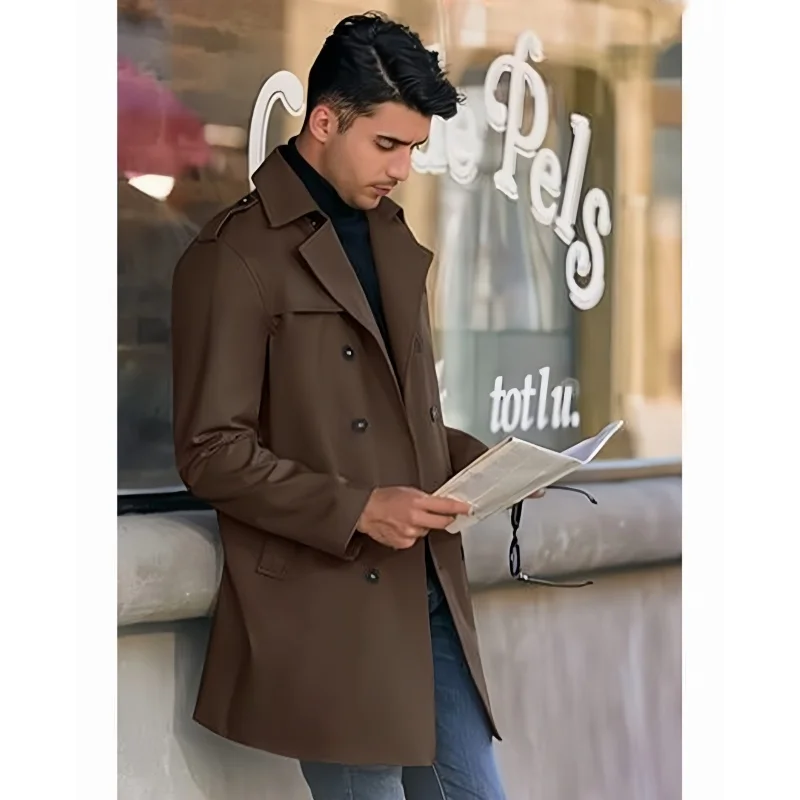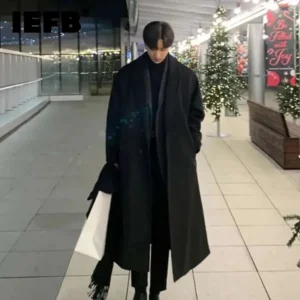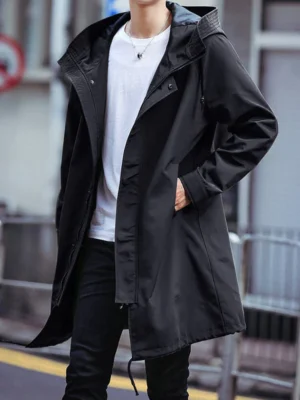Understanding the Double-Breasted Coat’s Formal Power
The double-breasted coat stands as a hallmark of refined masculine style, instantly recognizable by its overlapping front panels and two parallel rows of buttons. This distinctive design creates a structured silhouette that commands attention in any formal setting, making it a powerful addition to the sophisticated man’s wardrobe.
What sets the double-breasted coat apart is its inherent formality. Unlike its single-breasted counterpart, this style makes a deliberate statement of elegance and authority. The overlapping fabric creates a more substantial front presence, while the peak lapels that typically accompany this design draw the eye upward and outward, enhancing shoulder width and creating the coveted “V” silhouette that has long been associated with masculine power dressing.
The double-breasted coat’s journey through menswear history reveals its deep roots in formal tradition. Originally derived from military naval uniforms, this style transitioned to civilian wear while maintaining its authoritative presence. The ultimate guide to men’s double-breasted coats explores this rich heritage in detail, providing context for understanding its continued significance.
Modern interpretations have brought this classic style back to prominence, with designers embracing the structured elegance that defines double-breasted outerwear. The advantages of double-breasted coats extend beyond mere aesthetics—they offer superior chest coverage for cold weather protection while maintaining an unmatched level of sophistication.
For those seeking to project confidence and refinement at formal occasions, few garments can match the double-breasted coat’s ability to elevate an entire ensemble. Its architectural precision and deliberate formality make it an essential component for any man looking to master the art of elegant dressing.
The Foundation of Formality: Achieving the Perfect Fit
The cornerstone of a truly distinguished double-breasted look lies in its fit—a factor even more critical than with single-breasted alternatives. When improperly fitted, the double-breasted coat’s overlapping panels can create unflattering bulk or gapping, undermining its formal impact. Conversely, when tailored correctly, few garments offer such a transformative effect on a man’s appearance.
Key fit considerations for formal double-breasted excellence include:
Shoulders
– Should align precisely with your natural shoulder edge
– No divots or wrinkling at the shoulder seam
– Sleeve head should sit smoothly without bunching
Chest
– Panels should lie flat when buttoned without strain
– No horizontal pulling or wrinkles across chest
– Enough room for a suit jacket underneath without constriction
Waist
– Gentle suppression that follows your natural waistline
– Creates the signature “V” silhouette from shoulders to waist
– Bottom edge of coat should hang cleanly without flaring
Length
– For formal occasions, coat should typically cover your seat
– Sleeves should reveal ¼ to ½ inch of shirt cuff when arms are relaxed
– Overall proportions should balance your height
The expert guide to double-breasted coat fit provides comprehensive measurements and techniques for achieving this precise fit across different body types. While slim, athletic builds might gravitate toward more aggressive waist suppression, fuller figures can benefit from a more moderate shaping that still maintains the coat’s elegant lines without strain.
Button configuration significantly impacts both fit and formality. The classic 6×2 arrangement (six buttons with two functioning) presents the most traditional formal appearance, while 4×2 can create a more contemporary formal impression. Each configuration should be positioned to flatter your proportions and ensure the coat closes at your natural waist.
Professional tailoring is an investment that distinguishes truly formal double-breasted attire from merely adequate presentations. Even the finest coat requires customization to your specific proportions to achieve the commanding formal presence this style promises.
Formal Shirt Selection for Double-Breasted Elegance
The shirt forms the critical foundation for a formal double-breasted ensemble, and proper selection requires thoughtful consideration of proportion, fabric, and formality level. The substantial presence of double-breasted lapels demands shirts that can maintain visual balance while complementing the coat’s inherent formality.
For maximum formal impact, prioritize these shirt characteristics:
Collar Style: Spread or cutaway collars provide the ideal counterbalance to peaked lapels, creating harmonious proportions. The wider collar opening echoes the outward sweep of the lapels, while providing sufficient space for larger tie knots.
Fabric Quality: Two-ply cotton with higher thread counts (100+ thread count) delivers the refined appearance formal occasions demand. Twill offers subtle texture, while poplin provides a crisper, more formal finish that enhances the structured nature of double-breasted styling.
Proper Fit: Double-breasted coats leave less room for error in shirt fitting. The collar should stand cleanly without gaps, while the body should provide enough room for movement without excess fabric that could bunch under the overlapping coat panels.
Color Selection: White remains the pinnacle of formality, particularly for black-tie events. Light blue provides a sophisticated alternative for business formal settings, while subtle patterns like hairline stripes can introduce controlled visual interest without undermining formality.
For elevated formal occasions, French cuffs provide the appropriate level of refinement, creating the perfect canvas for statement cufflinks that complement other metal elements in your ensemble. Standard barrel cuffs remain appropriate for business formal settings where the double-breasted coat is already making a substantial statement.
The importance of shirt collar proportion cannot be overstated—when properly selected, the collar frames your face while creating visual harmony with the coat’s lapels. This relationship between collar spread and lapel width establishes the foundation upon which all other formal accessories build.
Explore our selection of men’s double-breasted overcoats to discover pieces specifically designed to accommodate proper formal shirt styling.
Neckwear Mastery: Ties and Bow Ties
The substantial presence of a double-breasted coat creates a backdrop against which neckwear becomes a focal point of formal expression. Mastering this element requires understanding both proportion and formality hierarchies that govern appropriate tie selection.
For tie width, the rule of balance prevails: the width of your tie should echo the width of your lapel. Since double-breasted coats typically feature wider peak lapels, ties in the 3 to 3.5-inch range provide appropriate visual weight. Overly skinny ties create jarring disproportion, while excessively wide options appear dated rather than formal.
Formal occasions call for premium tie fabrications:
* Pure silk: The standard for formal settings, providing subtle luster that complements wool coating
* Silk-wool blends: Introduce texture while maintaining elegance, ideal for winter formal events
* Grenadine: Textured silk that adds visual interest while preserving formality
The knot selection should complement the substantial collar spread typically paired with double-breasted coats. The Full Windsor creates a symmetrical triangle that balances wider lapels, while the Half-Windsor offers a slightly less substantial alternative that maintains formal propriety. The four-in-hand, while acceptable for less formal settings, generally lacks the visual weight necessary for double-breasted formality.
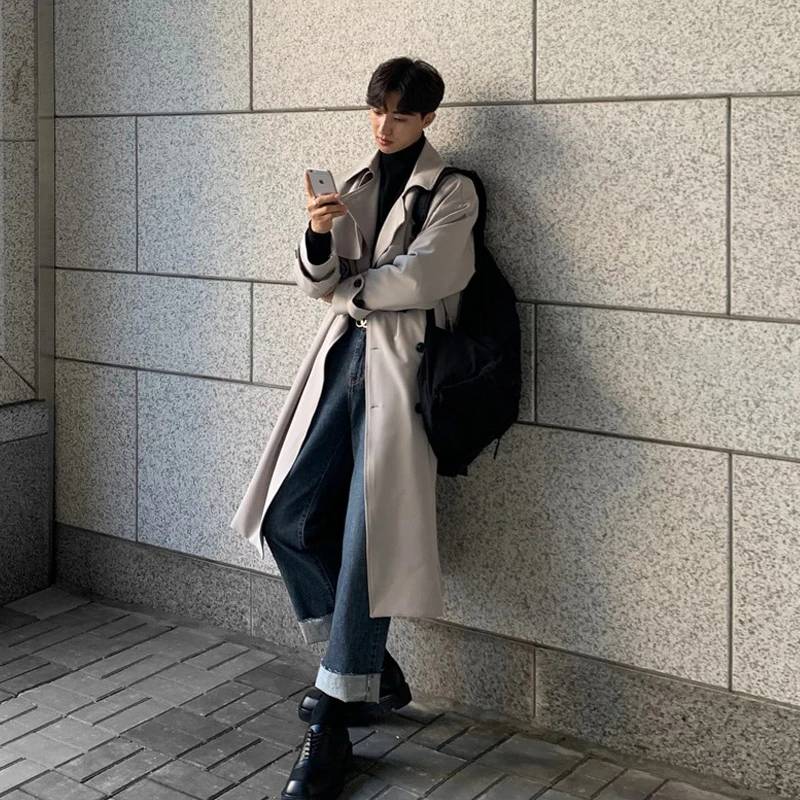
For black-tie events, the bow tie becomes non-negotiable. Traditional black silk in either satin or grosgrain represents the pinnacle of formality, with hand-tied versions offering subtle asymmetry that signals sartorial expertise. Pre-tied options, while convenient, lack the character and authenticity formal occasions deserve.
Color coordination follows formal convention: navy, burgundy, and deep forest green provide classic options that complement traditional coating while maintaining appropriate restraint. Patterns should remain subtle for maximum formality—small repeating motifs, understated stripes, or solid colors with minimal texture keep the focus on the overall composition rather than any single element.
Formal Trouser Pairing Principles
While the double-breasted coat commands significant attention, trousers provide the crucial foundation that completes a cohesive formal appearance. The substantial upper body presence created by overlapping front panels requires thoughtful trouser selection to maintain balanced proportions and appropriate formality.
For true formal elegance, consider these essential guidelines:
Rise and Positioning: Higher-rise trousers create the most harmonious formal silhouette with double-breasted coats. The waistband should sit at your natural waist, allowing the coat’s bottom button to hit at the proper position without exposing excessive shirt between coat bottom and trouser top.
Pleats vs. Flat Front: While contemporary styling often favors flat-front trousers, traditional forward pleats complement the classical nature of double-breasted styling particularly well. They provide additional comfort when seated while maintaining a clean drape when standing—both essential considerations for formal events.
Proper Break: A slight break where the trouser meets the shoe represents the most versatile formal option, though traditional styling may incorporate a full break. Avoid cropped styles that create excessive ankle exposure, as these undermine the formality double-breasted styling demands.
Waist Treatments: Side adjusters or extended waistbands eliminate the need for belts, creating a cleaner formal silhouette. Brace buttons (for suspenders) provide another traditional option that enhances the formal nature of the ensemble.
The comprehensive guide to styling double-breasted coats explores these relationships in greater detail, offering specific recommendations for different body types and formal occasions.
Fabric coordination between coat and trousers follows formal tradition: matching trouser fabric creates a suit-like formal impression, while high-contrast combinations (navy coat with gray trousers, charcoal coat with cream trousers) maintain formality while introducing visual interest. For maximum formal impact, wool trousers with minimal texture provide the appropriate foundation that complements rather than competes with the structured coat.
Formal Footwear Selection
The formality of a double-breasted ensemble flows naturally from head to toe, making appropriate footwear selection the final critical component in mastering formal elegance. The substantial presence of a double-breasted coat establishes a high standard that your footwear must maintain.
In order of decreasing formality, these styles complement double-breasted formal wear:
Oxford Shoes
* The quintessential formal choice featuring closed lacing
* Patent leather versions represent the pinnacle of formality for black-tie events
* Calfskin with minimal broguing maintains formality for business and formal day events
Derby Shoes
* Open lacing creates slightly less formal appearance
* Plain toe versions remain appropriate for most formal settings
* Minimal decoration maintains necessary refinement
Monk Strap Shoes
* Single buckles offer a sophisticated alternative to laced options
* Clean, minimalist designs preserve formal appropriateness
* Quality hardware enhances rather than detracts from formal impression
For formal color selection, black leather represents the most traditional and versatile choice across all formal contexts. Dark brown provides an acceptable alternative for daytime formal events, particularly when paired with navy or lighter-toned coats, though black remains preferable for evening functions.
Explore our collection of men’s dress coats to discover elegant outerwear designed to complement formal footwear selections.
Proper shoe maintenance becomes especially important in formal contexts—immaculate polish creates the subtle luster that distinguishes truly formal footwear. Attention to details like edge dressing (the finished sides of soles and heels) ensures no aspect undermines your careful formal presentation.
Sock selection follows formal convention: over-the-calf length prevents exposed skin when seated, while colors should match trouser shade rather than shoes to create a continuous visual line from waist to foot. Subtle patterns may be incorporated for controlled personal expression, though solid colors represent the safest formal choice.
Essential Formal Accessories
The refined nature of double-breasted styling provides the perfect framework for thoughtfully selected accessories that enhance rather than overwhelm your formal presentation. Each element should contribute to a cohesive whole, with quality and restraint as guiding principles.
Pocket Squares
The welted breast pocket of your double-breasted coat practically demands the finishing touch of a well-chosen pocket square. For maximum formality:
* White linen or cotton provides timeless elegance
* The presidential fold (straight horizontal edge) or single-point fold maintains appropriate restraint
* Texture rather than bold pattern offers subtle visual interest
* Material should complement but not exactly match tie fabric
Watches
Formal occasions call for timepieces that embody understated sophistication:
* Slim dress watches with minimal complications
* Leather straps that coordinate with your footwear
* Cases that match other metal elements in your ensemble
* Dials featuring clean designs with roman or stick markers
Cufflinks and Studs
These small metal elements provide focused points of refinement:
* Silver, gold, or platinum create appropriate formal presence
* Mother-of-pearl or onyx offer traditional formal elegance
* Understated designs without flashy gemstones
* Coordinated metals across all visible hardware
Styling formal coats with suits requires particular attention to these accessory relationships, ensuring harmonious integration between layers.
Formal Scarves
When wearing your double-breasted coat outdoors, a formal scarf provides both function and sophistication:
* Cashmere or fine wool in solid colors maintains appropriate refinement
* Proper draping techniques include the formal overhand or cross-and-tuck methods
* Width should be proportional to the substantial collar of your coat
* Colors that complement rather than contrast with your coat maintain formal cohesion
Formal Gloves
Complete your formal outerwear presentation with appropriate hand coverings:
* Leather gloves in black or brown (matching your footwear)
* Cashmere or wool lining for comfort without bulk
* Proper fit with minimal excess material at fingertips
* Traditional three-point stitching for authentic formal detailing
Remember that formal accessorizing follows the principle of thoughtful restraint—each element should appear deliberate rather than coincidental, yet the overall effect should never feel overwrought or ostentatious.
Double-Breasted Formality for Business Settings
The double-breasted coat makes a distinct impression in professional environments, projecting authority and attention to detail that can significantly impact business interactions. Mastering this specific application requires understanding both traditional business formal codes and the unique capabilities of double-breasted styling.
For maximum business impact, these color choices create appropriate formal presence:
* Navy blue represents the pinnacle of business formality, conveying trustworthiness and stability
* Charcoal gray projects sophisticated seriousness appropriate for conservative settings
* Subtle pinstripes introduce controlled pattern while maintaining professional decorum
* Camel or lighter grays can provide distinguished alternatives for specific seasonal contexts
Fabric selection significantly influences business formal perception:
* Worsted wool with minimal texture presents the most versatile business formal option
* Flannel introduces subtle texture appropriate for winter business settings
* Super 120s-150s wool strikes the ideal balance between refinement and durability
* Barathea weave creates a sophisticated matte finish ideal for important business functions
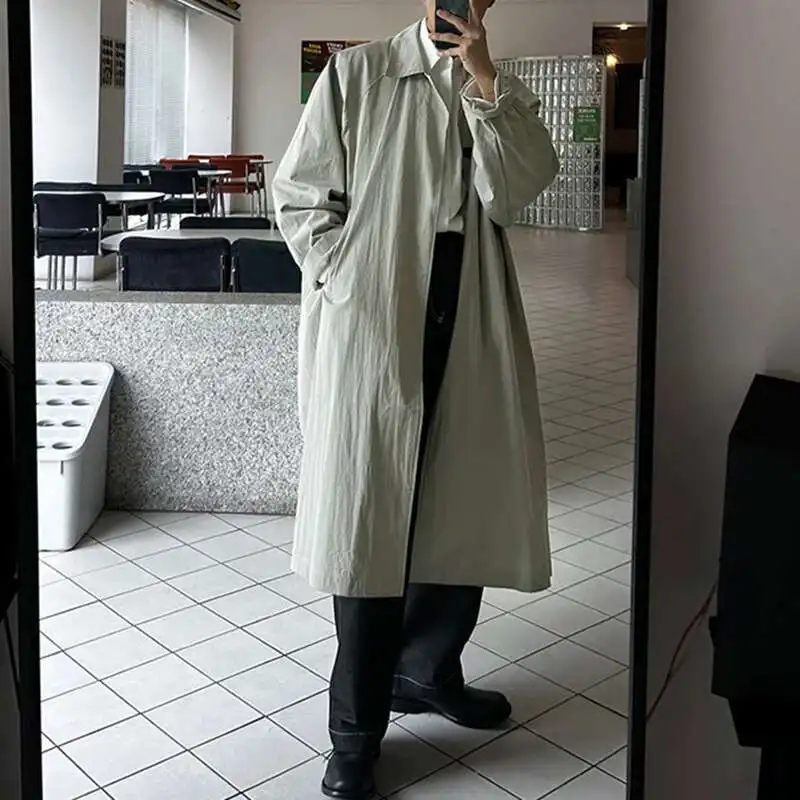
The “power dressing” associations of double-breasted styling can be strategically leveraged in business environments where perception matters. The structured shoulders and overlapping front create a more substantial physical presence, while proper tailoring ensures this authority projects confidence rather than domination.
Modern interpretations have slightly narrowed traditional double-breasted proportions, creating business-appropriate options that reference classic styling while avoiding outdated bulk. Strategic fabric choices in lighter weights help contemporary business professionals avoid overheating in modern office environments while maintaining formal propriety.
Our collection of black overcoats offers several options specifically designed for business formal settings, combining traditional authority with contemporary comfort.
Mens Cashmere Overcoat, Mens Hooded Winter Coat, Mens Wool Blend Coat
Price range: $128.72 through $139.68 Select options This product has multiple variants. The options may be chosen on the product pageMens Black Overcoat, Mens Black Wool Coat, Mens Wool Overcoat
$339.18 Select options This product has multiple variants. The options may be chosen on the product pageMens Grey Overcoat, Mens Wool Blend Coat, Mens Wool Overcoat
$201.28 Select options This product has multiple variants. The options may be chosen on the product pageMens Herringbone Coat, Mens Long Overcoat, Mens Wool Overcoat
Price range: $197.16 through $203.69 Select options This product has multiple variants. The options may be chosen on the product pageMens Black Overcoat, Mens Long Overcoat
Price range: $100.12 through $173.24 Select options This product has multiple variants. The options may be chosen on the product pageMens Dress Coat, Mens Long Overcoat
$76.76 Select options This product has multiple variants. The options may be chosen on the product page
Wedding Formality with Double-Breasted Coats
The celebratory nature of weddings provides the perfect showcase for double-breasted formal elegance, with specific styling considerations depending on your role in the proceedings and the formality level of the event itself.
For wedding guests, double-breasted styling offers distinguished formality without upstaging key participants:
* Navy or mid-gray provides appropriate formality while respecting the wedding party’s prominence
* Subtle pattern adds controlled visual interest appropriate for celebratory contexts
* Accessory choices can introduce measured personality while maintaining formal propriety
* Seasonal fabric weights ensure comfort during potentially lengthy ceremonies and receptions
Groomsmen wearing double-breasted coats create a unified formal impression that photographs beautifully:
* Consistent styling across the wedding party establishes visual cohesion
* Distinctive button configurations or lapel treatments can distinguish from guest attire
* Coordinated accessories reinforce wedding colors while maintaining formal elegance
* Proper fit for all party members ensures no distracting inconsistencies
For the groom himself, a double-breasted coat offers distinctive formality that appropriately sets him apart:
* Premium fabric with subtle sheen creates appropriate focus
* Potential for distinctive details like contrast buttonholes or specialized lining
* Perfect tailoring ensures confidence during this significant occasion
* Strategic color choice that complements the overall wedding palette while maintaining formality
The definitive guide to wearing double-breasted coats explores appropriate occasions in greater detail, with specific wedding recommendations across different formality levels.
Seasonal considerations significantly impact wedding formal wear:
* Summer weddings may require lightweight wool or wool-silk blends
* Winter ceremonies benefit from flannel or heavier worsted options
* Spring/fall events can leverage medium-weight fabrics with seasonal color influences
* Indoor/outdoor considerations should inform fabric selection for optimal comfort
For daytime weddings, lighter neutrals may be appropriate, while evening events typically call for deeper tones that project formal sophistication after dark. Throughout all wedding contexts, the double-breasted coat’s inherent formality makes it particularly well-suited for these significant celebrations.
Black-Tie Excellence with Double-Breasted Styling
At the pinnacle of formal dressing, black-tie occasions showcase the double-breasted coat’s maximum formal potential. Whether as a dinner jacket or formal overcoat, double-breasted styling creates distinctive presence that honors traditional formal codes while allowing subtle personal expression.
For double-breasted dinner jackets (tuxedos), these specifications ensure proper black-tie adherence:
* Peak lapels faced in silk satin or grosgrain that match trouser striping
* Proper button stance that creates ideal “V” formation
* Traditional black or midnight blue as the most formal options
* Jetted pockets without flaps for cleanest formal lines
The formal shirt pairing requires equal attention:
* Crisp white with French cuffs as the only appropriate option
* Either pleated or piqué front depending on formality level
* Proper studs rather than buttons for traditional presentation
* Appropriately sized spread collar to accommodate bow tie
Speaking of which, the bow tie represents the only acceptable black-tie neckwear:
* Black silk in either satin or grosgrain
* Hand-tied for authentic formal character
* Proportioned to balance face shape and collar width
* Precise symmetry that demonstrates attention to detail
Our selection of wool overcoats includes formal options specifically designed to complement black-tie attire with appropriate refinement.
For outerwear over black-tie ensembles, double-breasted styling provides ideal formal protection:
* Black or midnight blue maintains formal consistency
* Peak lapels echo dinner jacket styling
* Slightly longer length provides comprehensive coverage
* Simplified pocket treatment maintains clean formal lines
While traditional black-tie specifications remain relatively fixed, seasonal interpretations allow controlled variation:
* Winter black-tie might incorporate velvet double-breasted dinner jackets in deep jewel tones
* Summer formal events might feature double-breasted dinner jackets in cream (tropical black-tie)
* Traditional fabrications remain essential regardless of seasonal adaptations
* Proper wool barathea represents the most versatile black-tie fabric across seasons
Buttoning Rules and Formal Etiquette
Few elements distinguish the knowledgeable formal dresser more clearly than proper adherence to buttoning conventions. For double-breasted coats, these rules carry particular significance due to the style’s inherent formality and historical tradition.
The fundamental rule for double-breasted coats is straightforward yet essential: unlike single-breasted styles, a double-breasted coat should remain buttoned whenever you are standing. This maintains the coat’s intended lines and prevents the overlapping front panels from hanging awkwardly.
For 6×2 configurations (six buttons with two functioning):
* Button only the bottom functioning button for proper drape
* The top button remains decorative, not functional
* This creates the ideal “V” formation from shoulders to waist
* The hidden jigger/anchor button provides additional stability
For 4×2 configurations:
* Both functioning buttons should be fastened when standing
* This higher button stance creates a slightly more contemporary look
* Still maintains the essential formal structure of the style
* Creates slightly more waist emphasis
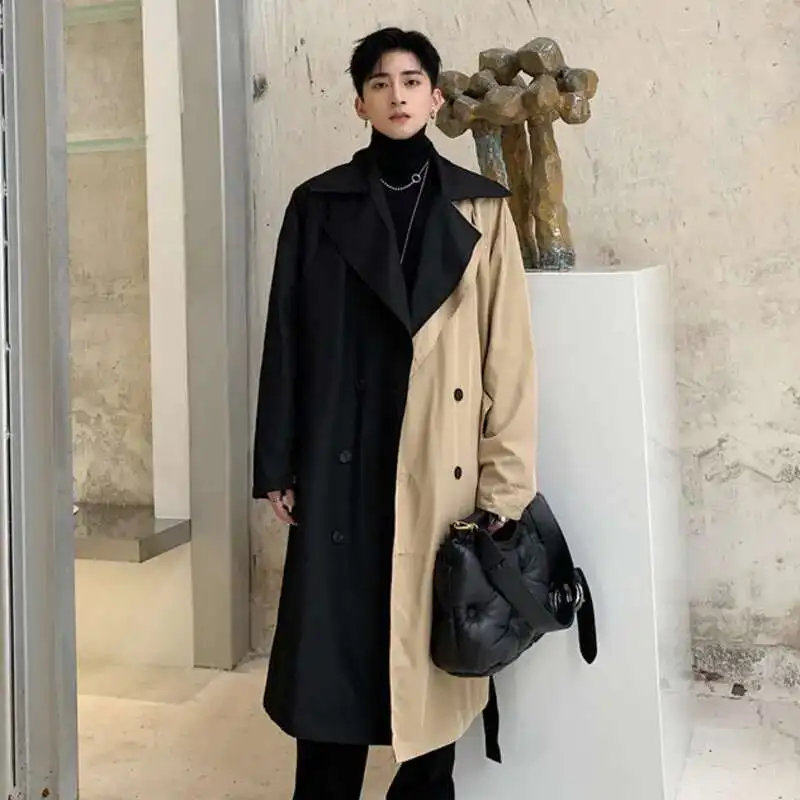
When seated, etiquette does permit unbuttoning your coat for comfort, though in the most formal settings, maintaining a buttoned stance even when seated demonstrates particular attention to traditional form. Upon standing, immediately rebuttoning ensures continuous formal propriety.
The comprehensive guide to proper buttoning techniques explores these conventions in detail, including their historical origins in military and aristocratic dress, where function gradually evolved into formal signaling.
The hidden jigger or anchor button deserves special mention—this interior button creates proper tension across the overlapping panels, ensuring clean lines without visible strain. Forgetting this essential fastening is a common oversight that immediately undermines formal presentation.
Proper buttoning directly supports the V-shaped silhouette that makes double-breasted styling so flattering, directing attention upward toward the face and shoulders while creating the waist suppression that distinguishes formal tailoring from more casual alternatives.
Fabric Selection for Maximum Formality
The tactile quality of your double-breasted coat fundamentally influences its formal impact, with certain fabrics inherently projecting greater refinement than others. Understanding the formal hierarchy of coating materials ensures selections appropriate to your specific formal needs.
In descending order of formal propriety:
Worsted Wool
* Smooth finish with minimal texture
* Clear, defined twill pattern
* Weights between 10-16 oz depending on season
* Natural wrinkle resistance maintains formal appearance
Wool Flannel
* Slight nap creates subtle depth
* Soft hand-feel with sophisticated matte appearance
* Primarily for fall/winter formal occasions
* Traditional option for business formal settings
Cashmere and Cashmere Blends
* Ultimate refinement with subtle luster
* Exceptional drape that enhances structured tailoring
* Luxurious hand-feel appropriate for prestigious occasions
* Premium option for evening formal wear
Our collection of cashmere overcoats represents this pinnacle of formal material selection.
Barathea
* Distinctive broken rib pattern
* Traditional formal finish with subtle texture
* Excellent drape with appropriate weight
* Historically associated with diplomatic and formal dress
For formal patterns, solid colors provide the most versatile formal foundation, while subtle variations introduce controlled visual interest without undermining formality:
* Pinstripes (fine vertical lines) offer traditional business formal character
* Chalk stripes (slightly wider, softer-edged stripes) provide classic formal elegance
* Shadow stripes (subtle tone-on-tone patterns) create depth while maintaining formality
* Glen checks at very small scale can maintain formality for specific daytime contexts
Seasonal weight considerations remain important even in formal contexts:
* Winter formal occasions: 14-16 oz coating provides appropriate substance
* Transitional seasons: 12-14 oz balances structure with comfort
* Summer formal events: 10-12 oz maintains necessary drape without excess weight
Quality indicators in formal fabrics include tight, consistent weaving, natural fiber content, proper finishing that enhances drape, and appropriate weight that maintains structure through extended wear.
Color Theory for Formal Double-Breasted Styling
Color selection significantly impacts formal perception, with certain choices inherently projecting greater formality than others. Understanding these hierarchies enables appropriate selection across different formal contexts while maintaining the double-breasted coat’s inherent elegance.
The formal color spectrum for double-breasted coats follows traditional conventions:
* Navy blue represents versatile formality appropriate across most contexts
* Charcoal gray provides sophisticated neutrality ideal for business formal settings
* Black delivers maximum formality, particularly for evening functions
* Camel/tan offers seasonal formality for specific daytime occasions
* Burgundy/oxblood can provide controlled distinctiveness while maintaining formality
Seasonal considerations interact with formal color conventions:
* Winter formal events favor deeper, richer tones with greater saturation
* Summer formality permits slightly lighter variations while maintaining depth
* Spring/fall transitions allow slightly more adventurous formal coloration
* Evening functions consistently demand deeper tones regardless of season
Coordinating formal colors requires systematic thinking:
* The coat typically represents the darkest element in the ensemble
* Trousers can match exactly (maximum formality) or provide moderate contrast
* Shirts should create clear distinction through lighter tones
* Accessories provide controlled color accents while respecting formal restraint
The comprehensive comparison of double-breasted and single-breasted styles explores these color relationships in detail, with specific guidance on formal impact.
Light significantly affects formal color perception:
* Natural daylight reveals subtle color variations and texture
* Evening artificial lighting can flatten certain colors while enhancing others
* Traditional formal colors were developed specifically for how they appear in formal settings
* Color selection should consider the specific lighting conditions of your formal occasion
Personal coloring (skin tone, hair color) interacts with formal color choices:
* Higher contrast individuals often benefit from stronger formal color definition
* Lower contrast complexions may be better complemented by more subtle formal combinations
* This personal element can introduce nuance within formal color conventions
* Traditional formal colors were selected specifically for their universal flattery
Maintaining Your Formal Double-Breasted Investment
The substantial investment represented by quality formal wear deserves proper care to maintain its distinguished appearance through years of use. Double-breasted coats require particular attention due to their structured nature and overlapping front panels.
Essential storage practices include:
* Wide, contoured wooden hangers that support shoulders without distortion
* Hanging that allows air circulation around the entire garment
* Brush after each wearing with a proper clothes brush to remove surface particles
* Appropriate garment bags that protect from dust while allowing fabric to breathe
Cleaning formal double-breasted coats requires strategic restraint:
* Dry clean only when genuinely necessary, typically 1-2 times per season
* Choose cleaners experienced with formal wear and structured garments
* Specify any special fabric considerations (cashmere, blends, etc.)
* Allow complete airing out after cleaning before storage
Button maintenance ensures continued formal propriety:
* Periodically check security of all buttons, including the crucial jigger button
* Have loose buttons professionally reinforced before loss occurs
* Keep matching replacement buttons secure for future needs
* For formal horn or mother-of-pearl buttons, avoid harsh chemical exposure
When traveling with formal double-breasted coats:
* Use proper garment bags designed for structured clothing
* Fold only along natural lines if absolutely necessary
* Steam or press upon arrival to restore proper drape
* Allow complete hanging time before wearing
Seasonal storage considerations include:
* Thorough cleaning before extended storage
* Cedar elements to deter moths without direct contact to fabric
* Climate-controlled conditions when possible to prevent mildew
* Complete airing out before returning to rotation
With proper care, premium formal wear can maintain its distinguished appearance and structural integrity for decades, making it a true investment in personal presentation rather than a temporary expense.
Can a Double-Breasted Coat Work for All Body Types?
The perception that double-breasted coats only flatter certain physiques represents one of the most persistent misconceptions in formal menswear. With proper tailoring and strategic styling choices, this formal style can enhance virtually any body type through its structured elegance.
For taller men:
* Slightly lower button stance creates balanced proportions
* 6×2 configuration extends the visual line appropriately
* Horizontal elements like ticket pockets can provide beneficial visual breaking
* Wider peak lapels maintain appropriate scale for larger frames
For shorter men:
* Higher button stance elongates the leg line
* 4×2 configuration prevents overwhelming proportions
* Closer button spacing creates vertical emphasis
* Slightly narrower lapels maintain appropriate scale
For broader builds:
* Moderate waist suppression creates definition without strain
* Structured shoulders with slight roping provide clean lines
* Strategic pattern selection (vertical elements) enhances height
* Proper length prevents horizontal emphasis at coat bottom
For slimmer builds:
* Additional chest drape prevents concave appearance
* Slightly extended shoulders create beneficial structure
* Heavier fabrics provide substance and improved drape
* Peak lapels with moderate width add visual presence
The key understanding is that double-breasted styling isn’t inherently unflattering for any body type—rather, it requires more precise tailoring to achieve its optimal effect. Ready-to-wear options often fail to provide this precision, creating the misconception that the style itself is limiting rather than the execution.
Professional tailoring represents the essential investment that transforms double-breasted potential into formal reality across all body types. With proper customization to your specific proportions, this style offers unique formal benefits regardless of physique.
What Makes Double-Breasted Coats Particularly Formal?
The distinctive formality of double-breasted styling derives from multiple design elements that collectively create a more structured and deliberate appearance than single-breasted alternatives. Understanding these formal qualities helps leverage their impact appropriately across different formal contexts.
Structural elements contributing to enhanced formality include:
* Overlapping front panels that create greater visual substance
* Button configuration that requires deliberate fastening rather than casual option
* Typically wider peak lapels that frame the chest and face more dramatically
* Higher armholes and more structured shoulders that create cleaner lines
* Additional fabric that maintains cleaner drape when in motion
Historically, double-breasted styling evolved in contexts where formality signaled authority and position—military officers, business leaders, and aristocracy adopted these more structured garments specifically for their commanding presence. This heritage continues to influence our perception of the style’s inherent formality.
The required buttoned stance creates a more deliberate appearance than single-breasted alternatives, which can be worn open casually. This non-optional structure transforms the wearer’s posture and movement, inherently creating more formal body language that complements formal social contexts.
Peak lapels, which typically accompany double-breasted styling, represent the most formal lapel type across all tailored garments. Their upward sweep draws attention to the face and broadens the chest, creating authoritative presence particularly suited to formal settings where personal impact matters.
These combined elements create what fashion psychologists describe as “enclothed cognition”—the garment itself influences both how the wearer is perceived and how they behave, naturally elevating interactions to a more formal register through its structured presence.
Is a Waistcoat Appropriate with a Formal Double-Breasted Coat?
Traditional tailoring convention generally advises against combining a waistcoat with a double-breasted coat, based on both practical and aesthetic considerations specific to formal dressing.
The primary reason stems from redundancy—the double-breasted coat’s overlapping front panels already create the chest coverage and layered appearance that waistcoats provide for single-breasted styling. Adding this additional layer can create excessive bulk that disrupts the clean lines formal occasions demand.
Visually, the double-breasted coat’s button stance typically obscures most of the waistcoat, rendering it largely invisible except at the very top. This creates a “neither here nor there” effect where the waistcoat adds bulk without contributing to the visual composition—an inefficiency formal dressing typically avoids.
For those determined to incorporate both elements, these adaptations can minimize conflict:
* Choose a low-cut waistcoat that appears only minimally above the coat’s buttoning point
* Select extremely lightweight fabrics for both layers to reduce bulk
* Ensure precise tailoring of both garments to prevent binding or restriction
* Consider this combination primarily for extreme cold weather where additional layering serves practical function
Alternative approaches that achieve similar formal layering include:
* Selecting shirts with formal detailing like pleated fronts or piqué bibs
* Incorporating formal scarves that frame the chest when outdoors
* Choosing double-breasted styles with additional formal details like ticket pockets or sleeve buttons
* Focusing on exceptional fit that creates the elegant silhouette without additional layers
The double-breasted coat itself creates sufficient formal presence without requiring supplementary waistcoats. For maximum formal impact, focusing on perfect execution of the coat itself generally produces more sophisticated results than adding potentially conflicting elements.
How Do Seasonal Considerations Affect Formal Double-Breasted Styling?
Formal occasions occur throughout the year, requiring thoughtful adaptation of double-breasted styling across different climatic conditions while maintaining appropriate sophistication. Seasonal considerations influence fabric, weight, lining, and even color selection within formal parameters.
Winter formal events allow the double-breasted coat to showcase its practical origins:
* Heavier weight fabrics (14-16 oz) provide both warmth and superior drape
* Full canvas construction creates insulating air layers between fabric and lining
* Substantial linings in silk or bemberg provide additional warmth without bulk
* Deeper colors like midnight blue or charcoal complement the season’s formality
Summer formality requires strategic adaptation:
* Lighter weight wools (10-12 oz) maintain structure without excessive warmth
* Half-canvas construction reduces insulation while preserving chest shape
* Minimal lining (quarter or half-lined) promotes air circulation
* Slightly lighter formal colors can be appropriate for daytime functions
Transitional seasons benefit from medium-weight options (12-14 oz) that provide versatility across temperature fluctuations. These “three-season” fabrics represent the most versatile formal investment for variable climates.
Regardless of season, maintaining appropriate formal structure remains essential. Even summer-weight double-breasted coats should retain proper shoulder construction and chest shaping, as these elements define the formal silhouette regardless of fabric weight.
For year-round formal versatility, navy blue in appropriate seasonal weights provides the most adaptable foundation. This classic formal color transitions seamlessly across seasonal lighting conditions while maintaining consistent formal propriety across contexts.
Through thoughtful seasonal adaptation, the double-breasted coat can provide year-round formal elegance—confirming its status as not merely a winter garment but a versatile formal staple adaptable to any occasion that demands sophisticated presence.

